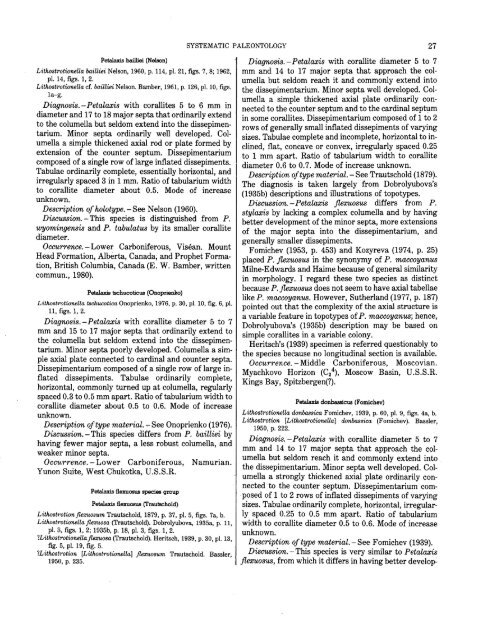Revision of Lithostrotionella - USGS
Revision of Lithostrotionella - USGS
Revision of Lithostrotionella - USGS
Create successful ePaper yourself
Turn your PDF publications into a flip-book with our unique Google optimized e-Paper software.
SYSTEMATIC PALEONTOLOGY 27<br />
Petalaxis bailliei (Nelson)<br />
<strong>Lithostrotionella</strong> bailliei Nelson, 1960, p. 114, pl. 21, figs. 7, 8; 1962,<br />
pl. 14, figs. 1, 2.<br />
<strong>Lithostrotionella</strong> cf. bailliei Nelson. Bamber, 1961, p. 126, pl. 10, figs.<br />
la-g.<br />
Diagnosis. -Petalaxis with corallites 5 to 6 mm in<br />
diameter and 17 to 18 major septa that ordinarily extend<br />
to the columella but seldom extend into the dissepimentarium.<br />
Minor septa ordinarily well developed. Columella<br />
a simple thickened axial rod or plate formed by<br />
extension <strong>of</strong> the counter septum. Dissepimentarium<br />
composed <strong>of</strong> a single row <strong>of</strong> large inflated dissepiments.<br />
Tabulae ordinarily complete, essentially horizontal, and<br />
irregularly spaced 3 in 1 mm. Ratio <strong>of</strong> tabularium width<br />
to corallite diameter about 0.5. Mode <strong>of</strong> increase<br />
unknown.<br />
Description <strong>of</strong> holotype.- See Nelson (1960).<br />
Discussion. -This species is distinguished from P.<br />
wyomingensis and P. tabulatus by its smaller corallite<br />
diameter.<br />
Occurrence.- Lower Carboniferous, Visean. Mount<br />
Head Formation, Alberta, Canada; and Prophet Formation,<br />
British Columbia, Canada (E. W. Bamber, written<br />
commun., 1980).<br />
Petalaxis tschucoticus (Onoprienko)<br />
<strong>Lithostrotionella</strong> tschucotica Onoprienko, 1976, p. 30, pl. 10, fig. 6, pl.<br />
11, figs. 1, 2.<br />
Diagnosis.-Petalaxis with corallite diameter 5 to 7<br />
mm and 15 to 17 major septa that ordinarily extend to<br />
the columella but seldom extend into the dissepimentarium.<br />
Minor septa poorly developed. Columella a simple<br />
axial plate connected to cardinal and counter septa.<br />
Dissepimentarium composed <strong>of</strong> a single row <strong>of</strong> large inflated<br />
dissepiments. Tabulae ordinarily complete,<br />
horizontal, commonly turned up at columella, regularly<br />
spaced 0.3 to 0.5 mm apart. Ratio <strong>of</strong> tabularium width to<br />
corallite diameter about 0.5 to 0.6. Mode <strong>of</strong> increase<br />
unknown.<br />
Description <strong>of</strong> type material.~ See Onoprienko (1976).<br />
Discussion.-This species differs from P. bailliei by<br />
having fewer major septa, a less robust columella, and<br />
weaker minor septa.<br />
Occurrence.- Lower Carboniferous, Namurian.<br />
Yunon Suite, West Chukotka, U.S.S.R.<br />
Petalaxis flexuosus species group<br />
Petalaxis flexuosus (Trautschold)<br />
LithostTotionjlexuosum Trautschold, 1879, p. 37, pl. 5, figs. 7a, b.<br />
<strong>Lithostrotionella</strong> jlexuosa (Trautschold). Dobrolyubova, 1935a, p. 11,<br />
pl. 3, figs. 1, 2; 1935b, p. 18, pl. 3, figs. 1, 2.<br />
?<strong>Lithostrotionella</strong>flexuosa (Trautschold). Heritsch, 1939, p. 30, pl. 13,<br />
fig. 5, pl. 19, fig. 5.<br />
?Lithostrotion [<strong>Lithostrotionella</strong>] jlexuosum Trautschold. Bassler,<br />
1950, p. 235.<br />
Diagnosis.-Petalaxis with corallite diameter 5 to 7<br />
mm and 14 to 17 major septa that approach t~e columella<br />
but seldom reach it and commonly extend into<br />
the dissepimentarium. Minor septa well developed. Columella<br />
a simple thickened axial plate ordinarily connected<br />
to the counter septum and to the cardinal sep~m<br />
in some corallites. Dissepimentarium composed <strong>of</strong> 1 to 2<br />
rows <strong>of</strong> generally small inflated dissepiments <strong>of</strong> varying<br />
sizes. Tabulae complete and incomplete, horizontal to inclined,<br />
nat, concave or convex, irregularly spaced 0.25<br />
to 1 mm apart. Ratio <strong>of</strong> tabularium width to corallite<br />
diameter 0.6 to 0.7. Mode <strong>of</strong> increase unknown.<br />
Description <strong>of</strong> type material.- See Trautschold (1879).<br />
The diagnosis is taken largely from Dobrolyubova's<br />
(1935b) descriptions and illustrations <strong>of</strong> topotypes.<br />
Discussion. - Petalaxis flexuosus differs from P.<br />
stylaxis by lacking a complex columella and by having<br />
better development <strong>of</strong> the minor septa, more extensions<br />
<strong>of</strong> the major septa into the dissepimentarium, and<br />
generally smaller dissepiments.<br />
Fomiehev (1953, p. 453) and Kozyreva (1974, p. 25)<br />
plac·ed P. flexuosus in the synonymy <strong>of</strong> P. mac_co¥an_us<br />
Milne-Edwards and Haime because <strong>of</strong> general similarity<br />
in morphology. I regard these , two species as distinct<br />
because P. flexuosus does not seem to have axial tabellae<br />
like P. maccoyanus. However, Sutherland (1977, p. 187)<br />
pointed out that the complexity <strong>of</strong> the axial structure is<br />
a variable feature in topotypes <strong>of</strong> P. maccoyanus; hence,<br />
Dobrolyubova's (1935b) description may be based on<br />
simple corallites in a variable colony.<br />
Heritsch's (1939) specimen is referred questionably to<br />
the species because no longitudinal section is available.<br />
Occurrence.- Middle Carboniferous, Moscovian.<br />
Myachkovo Horizon (C<br />
4<br />
2 ), Moscow Basin, U.S.S.R.<br />
Kings Bay, Spitzbergen(?).<br />
Petalaxis donbassicus (Fomichev)<br />
<strong>Lithostrotionella</strong> donbassica Fomichev, 1939, p. 60, pl. 9, figs. 4a, b.<br />
Lithostrotion [<strong>Lithostrotionella</strong>] donbassica (Fomichev). Bassler,<br />
1950, p. 222.<br />
Diagnosis. -Petalaxis with corallite diameter 5 to 7<br />
mm and 14 to 17 major septa that approach the columella<br />
but seldom reach it and commonly extend into<br />
the dissepimelitarium. Minor septa well developed. Columella<br />
a strongly thickened axial plate ordinarily connected<br />
to the counter septum. Dissepimentarium com-<br />
. posed <strong>of</strong> 1 to 2 rows <strong>of</strong> inflated dissepiments <strong>of</strong> varying<br />
sizes. Tabulae ordinarily complete, horizontal, irregularly<br />
spaced 0.25 to 0.5 mm apart. Ratio <strong>of</strong> tabularium<br />
width to corallite diameter 0.5 to 0.6. Mode <strong>of</strong> increase<br />
unknown.<br />
Description <strong>of</strong> type material.-See Fomichev (1939).<br />
Discussion.-This species is very similar to Petalaxis<br />
flexuos1.tS, from which it differs in having better develop~

















